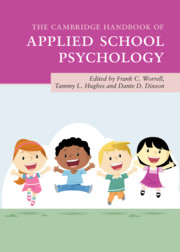Book contents
- The Cambridge Handbook of Applied School Psychology
- The Cambridge Handbook of Applied School Psychology
- Copyright page
- Contents
- Contributors
- Contributor Biographies
- Acknowledgments
- 1 Broadening the Focus of School Psychology Practice
- Part I Individual-Level Academic Interventions
- Part II Teacher- and System-Level Interventions
- Part III Interventions from Educational and Social/Personality Psychology
- Part IV Behavioral and Social-Emotional Interventions
- Part V Health and Pediatric Interventions
- Part VI Family Connections and Life Transitions
- Part VII Special Populations
- 33 School Psychologists in Early Childhood Settings
- 34 Identifying and Serving Gifted and Talented Students
- 35 How Best to Serve Court-Involved Youth in Schools
- 36 School-Based Interventions for Refugee Children and Adolescents
- Part VIII Conclusion
- Index
- References
35 - How Best to Serve Court-Involved Youth in Schools
from Part VII - Special Populations
Published online by Cambridge University Press: 18 September 2020
- The Cambridge Handbook of Applied School Psychology
- The Cambridge Handbook of Applied School Psychology
- Copyright page
- Contents
- Contributors
- Contributor Biographies
- Acknowledgments
- 1 Broadening the Focus of School Psychology Practice
- Part I Individual-Level Academic Interventions
- Part II Teacher- and System-Level Interventions
- Part III Interventions from Educational and Social/Personality Psychology
- Part IV Behavioral and Social-Emotional Interventions
- Part V Health and Pediatric Interventions
- Part VI Family Connections and Life Transitions
- Part VII Special Populations
- 33 School Psychologists in Early Childhood Settings
- 34 Identifying and Serving Gifted and Talented Students
- 35 How Best to Serve Court-Involved Youth in Schools
- 36 School-Based Interventions for Refugee Children and Adolescents
- Part VIII Conclusion
- Index
- References
Summary
As justice-involved youth often require intensive and individualized support, it is important for school personnel to be knowledgeable of juvenile justice parameters and theoretical frameworks that are used with this population. Individuals involved in developing school-based interventions should be aware of (a) the historical and contemporary contexts of both the educational and juvenile justice systems, with a focus on disproportionate contact; (b) the risk, need, and responsivity (RNR) model, as it provides a theoretical framework for criminal behavior and yields insight into contemporary justice-based programming; and (c) the juvenile adjudicative process and how schools might become involved. This knowledge base will help school-based personnel facilitate rehabilitation, avoid arbitrary punitiveness, and work collaboratively with court officials when appropriate.
Keywords
- Type
- Chapter
- Information
- The Cambridge Handbook of Applied School Psychology , pp. 613 - 633Publisher: Cambridge University PressPrint publication year: 2020



